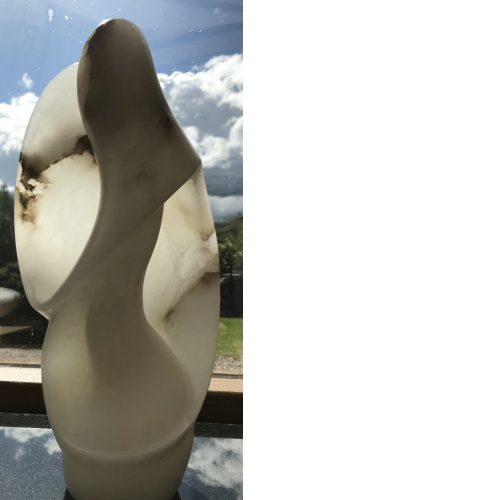Essays
Time Unfolding: Ruskin to Rovelli
Janet Manifold©
2019
From a presentation given at the conference, Celebrating the Art of Imperfection: John Ruskin and the Creative Arts in the 21st Century, Birmingham School of Art, May 2019.
 Time Unfolding: Janet Manifold 2019 ©
Time Unfolding: Janet Manifold 2019 ©
The notion of time unfolding underpins everything in many layers and interpretations. This brief essay about the alabaster sculpture, Time Unfolding, is intended to bridge the two centuries separating Victorian polymath, John Ruskin, and contemporary theoretical physicist, Carlo Rovelli.
The notion of truth to materials was integral to John Ruskin’s beliefs. As a sculptor there are three critical elements to this notion: the origin of the material, the methods used to create a sculpture, and the authenticity of the sculpted form.
Alabaster originally evaporated from seawater and, being a type of gypsum called hydrated calcium sulphate, it is essentially calcium. This is the origin of the material and the basis of my own sculptural practice.
Traditional carving methods are used because physical contact with the stone is essential to my personal process of creation. It is a slow, meditative process facilitating a co-operative dialogue with the stone.
Current work is based on shells. Alabaster formed from sea; the creatures making shells lived in the sea not only now, but also at the time alabaster was being formed 23 million years ago and, of course, the shells themselves are made of calcium. However, there is one significant difference. Shells are secreted by their living organism from inside out. I work from outside in. Nevertheless, the water from which alabaster formed flowed through those creatures when secreting their shells long ago.
So, opening up this stone to create a sculpture reveals particles which were part of a living ocean 23 million years ago. We are looking back in time to the origin of the material itself and to the life it once sustained.
As a polymath, John Ruskin was a passionate communicator about the networks connecting nature, art and society. A parallel can be drawn here because calcium also operates in networks, alabaster being calcium. In mammals it is not only the architecture of body - the bones and teeth – but also it holds the vital function of a neuro-transmitter, connecting electrical impulses throughout body and the brain. Calcium therefore is also a communicator. We can take this a stage further and argue that in humans this creates implicit functions: memory, imagination, consciousness: the things that make us who we are.
What is the significance of this interpretation of a broken shell? French philosopher, Gaston Bachelard, writes ‘An empty shell, like an empty nest, invites daydreams of refuge’. The broken shell represents the destruction of this protective refuge. The delicate, beautiful inner structures are revealed, the refuge becomes unsafe and exposed to the elements, fragile. Alabaster itself is a physically fragile material; it bruises and scratches, it dissolves in running water in a matter of days, not years, centuries or millennia. It has visual delicacy in its translucence, capturing light as it passes through the stone.
This piece of work becomes a metaphor for a number of things. First, for Ruskin’s own tremendous sensitivity and emotional fragility. Second, it acknowledges our increasing human fragility in the face of societal pressure, physically and mentally. Finally, here, now, today, the desperate fragility of our natural world - the land and sea. Two hundred years ago, Ruskin warned of encroaching damage to the environment and society occurring as a consequence of industrialisation. Now, our future looks very much more uncertain as time is unfolding.
To summarise, the origin of alabaster takes us back in time; the function of calcium embodies what it is to be human; the form of a broken shell acknowledges the fragility of our existence and the uncertainty of what may lie ahead.
But what is time? Carlo Rovelli argues gravity is granular and time has no meaning. Stone is protons and electrons moving around one another. It is a process. It’s a long process, but it is nevertheless a process. It is essentially interactions, things happening. We too are complex processes. We are not made of the same atoms as when we were children. We do not have the same thoughts we had as children. Our stability as an organism is therefore maintained through processing. Additionally, and importantly he asserts that time is a construct of human consciousness, not a fundamental principle of the universe. As we have discussed above, it is the function of calcium in the human brain which creates this consciousness and therefore our awareness of time passing.
This is the framework within which we exist and within which we are accountable for the consequences of our attitudes and activities.
The mystery of time has nourished philosophies and religions. Ruskin was deeply aware of time. He wanted us to linger, walk, think, look around us. To engage critically and creatively with the world beyond that which is measurable by science and take time to appreciate the sheer beauty of things. Two hundred years later Carlo Rovelli’s understanding of the fundamentals of the universe also embraces beauty, creativity and humanity. To him, it is the shortness of our human life which makes it both precious and beautiful.
What are we? Perhaps each of us is an infinitesimally small process within a process which began 13.8 billion years ago and will stretch forward to an infinite future. But we are so much more. We are memory and nostalgia, imagination and anticipation. Rovelli argues that this is time therefore we are time. Time unfolding is what it is to be human. Sometimes a source of anguish, but ultimately, it’s a tremendous gift.